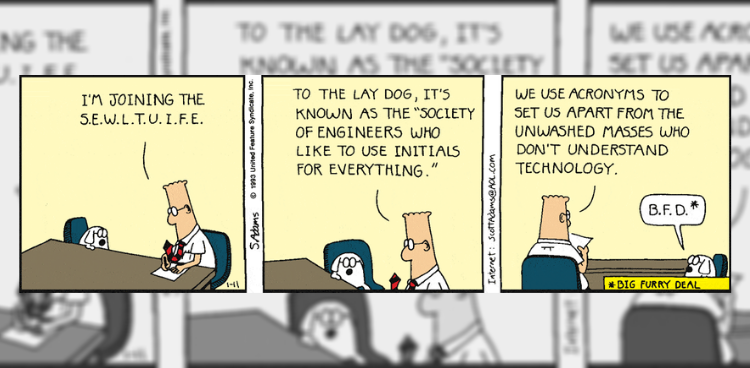Acronyms are one corporate communications trend we’d like to see end.
Have you ever gotten an email like this one?

If you’ve spent any time in the corporate world, you know this example is only slightly exaggerated. Most corporate communications contain at least this many acronyms; there’s just usually more text in the middle. While the prevalence of corporate jargon and acronyms is easy to laugh off, it’s also a real problem that has real costs for organizations in the form of time, misunderstanding, and distrust.
Acronyms don’t save time when you consider everyone’s time.
The main argument for acronyms is that they save time. The logic seems ironclad: it takes far less time to say or type “SCOTUS” than “Supreme Court of the United States.” But whose time are you saving?
When writing the email at the top of this post, J saved herself many keystrokes, maybe as much as a minute of her busy day. But she was not the only person involved. What about those EH TRDs, and the TSMs they were asked to cascade the message to? When you consider the total time it took every person in the audience to unpack this message (Googling, debating with colleagues, asking via the dreaded “reply-all”), the time-saving argument doesn’t look quite as solid.
Acronyms leave a lot of room for interpretation.
There’s also a real risk of misunderstanding. Most people assume that if they use certain acronyms on a regular basis, so do their colleagues and direct reports. Like most assumptions, this often falls flat under scrutiny.
Let’s take a statement that most people would probably agree with:
“Everyone working in software development knows API means application programming interface, or at least understands what an API is and does.”
Now let’s take a real-life example from my experience working on a major corporate software implementation project. The deployment team leaders had several conversations where they discussed APIs in what seemed like a strange context before I spoke up to ask for clarification. It turns out they weren’t talking about application programming interfaces at all; they were using the acronym to refer to a business process specific to that company.
Here’s the thing: More than half of the people working on the project (like myself) had no history working at the company. A large portion of the team was just as baffled as I was by the conversation, and just as relieved when the question was finally answered. But they were afraid to ask, for fear that their lack of understanding would reflect poorly on them.
Which brings us to the final flaw:
Acronyms increase the divisions that already exist within organizations and teams.
Going back to the example at the top of this post, you may have thought, “Sure, maybe all those acronyms caused more time and confusion for people further down on the org chart, but isn’t the VP’s time more valuable than anyone else’s?” Depending on where you work, that may be technically accurate. However, executives are responsible for setting the tone for their organization. When they choose to use acronyms in a message about strategic direction intended for large distribution, they need to choose their words wisely or risk alienating the very people they’re looking to inspire and lead.
So, what’s the solution? Should we Ban All Acronyms?

There are a few cases where acronyms really do save time without undermining your message or increasing divisions between departments and layers of the organization. To determine whether or not an acronym is actually effective in any given situation, you need to consider your audience first and foremost. Acronyms work well if they:
- Have an established and constant meaning to everyone in your target audience (for example: NYC in a publication aimed at New Yorkers)
- Are always referred to in acronym form – as in no one actually knows what the letters stands for; they only know what it means. (for example: SCUBA, AWOL)
However, there’s an even simpler rule of thumb: Spell it out on first mention. If you’re going to use the acronym again in the same piece, define it in parentheses and abbreviate with a clear conscience.
That should put a damper on the number of acronyms you use in your own writing. But what about incoming fire? Is there a way to shield yourself and others from this pernicious problem? My teammates at a major corporation known for rampant acronym use decided to give it a try. There were two simple parts to the plan:
- Question acronyms when you see them. Every time someone asks “what does that stand for?”, it creates a crack in the foundational assumption that everyone knows what it means.
- Stop feeding the acronym machine. If you’re ever in the position to name something – a project, a department, or a product – try to avoid reducing it to an acronym, even internally.
Now, I can’t tell you that this multinational corporation suddenly turned on its heels and ran away from anything in ALL CAPS. But within our team’s small sphere of influence, things started to change. Once you start mindfully excising exclusionary language from your vocabulary, you’ll find more knowing smiles and fewer blank stares.
Looking to upgrade your internal communications to create a more inclusive and dynamic corporate culture? Set up a consultation today.
